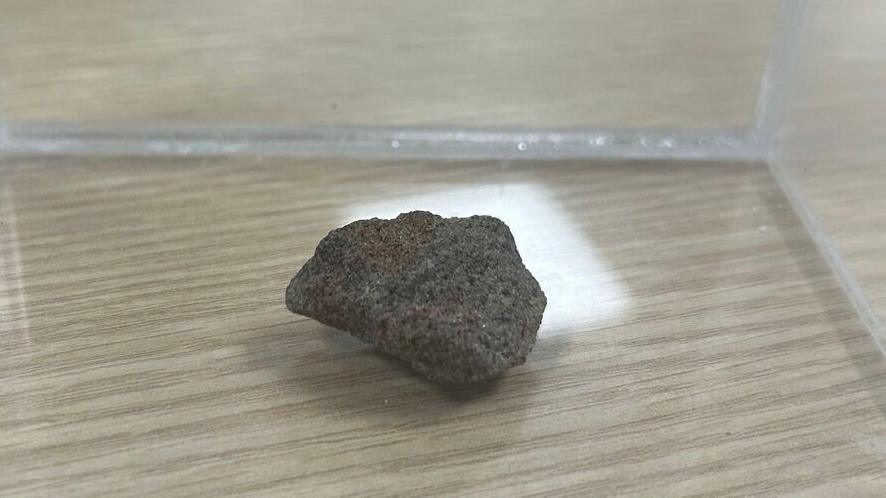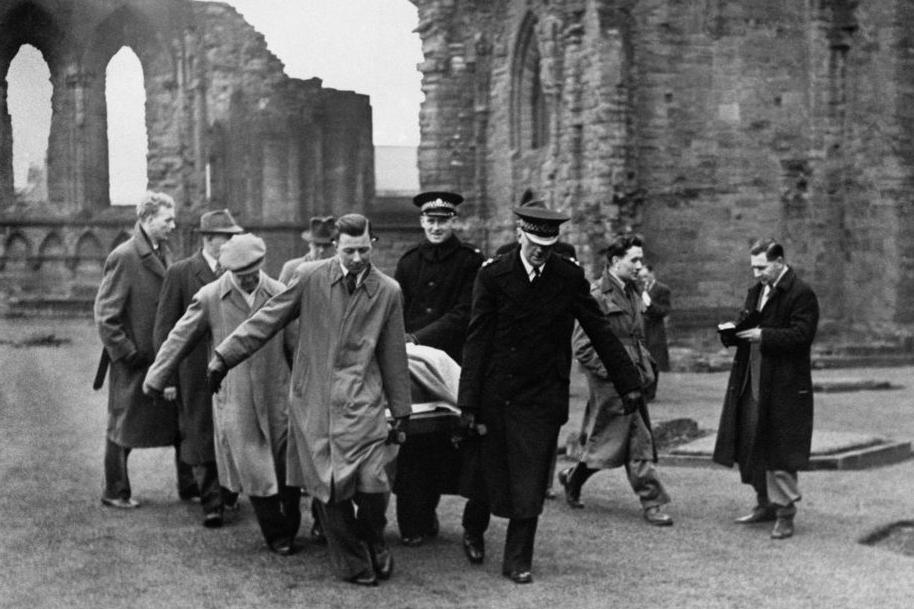Stone of Destiny fragments history revealed

The Stone of Destiny is currently on display at Perth Museum
- Published
The existence and fate of fragments of the Stone of Destiny have been revealed in new research.
The pieces were separated from the artefact when it was secretly repaired following its famous removal from Westminster Abbey in 1950 by nationalist students.
Stonemason and nationalist politician Bertie Gray, who oversaw the repair, numbered 34 fragments and gifted them and other unnumbered fragments to family members, trusted political friends, politicians, and journalists.
Prof Sally Foster from Stirling University said one fragment was traced to a museum in Australia.

A fragment was gifted to Queensland Museum in Australia with its certificate of authenticity
Prof Foster said the fragments were handed down by families and friends as heirlooms.
She has traced the fate of several fragments, one of which was gifted to the late former First Minister Alex Salmond.
The inch-sized piece turned up last year after it was found in storage at the SNP's headquarters.
Newly-released cabinet papers had earlier revealed it was given to Alex Salmond in 2008 by Sir Neil MacCormick, son of SNP co-founder John MacCormick who funded the 1950 raid.
Prof Foster's paper provides details of other nationalist politicians who had fragments.
These include Winnie Ewing, who wore a locket containing a chip when interviewed on television by David Frost in 1967 and Margo MacDonald who was given a fragment by Gray after she won the Govan by-election in 1973.

A fragment of the Stone of Destiny was gifted to Alex Salmond and kept at the SNP's headquarters
The research also sets out the story of a fragment which was gifted to a visiting Australian tourist by Gray.
On her death in 1967, the family donated the fragment, accompanying letter of authentication and Gray's business card, to Queensland Museum.
Canadian journalist Dick Sanburn received chip number 25 in 1951 and proudly kept it behind his desk at the Calgary Herald.
He said the fragments were "carefully numbered and recorded to prevent a flood of fakes".
Closer to home, one fragment was enshrined in a silver brooch, while another was wrapped in tissue paper and placed in a Bluebell matchbox and locked in a safe at a family home in Bannockburn before being buried with its keeper.
The students who stole the Stone of Destiny
- Published24 March 2023
Stone of Destiny takes centre stage at new museum
- Published28 March 2024
Stone of Destiny fragment 'genuine beyond reasonable doubt'
- Published17 May 2024
Prof Foster said the use of the Stone of Destiny in the coronation of King Charles and its move to a permanent home in Perth Museum in 2024 had renewed interest in the artefact.
She said: "However the existence and significance of a diverse, dispersed body of small fragments of the stone has been overlooked.
"Since my findings started to emerge, many members of the public have contacted me with their family's knowledge of credible stone fragments, often accompanied by supporting evidence – but there are many gaps yet to fill."
The 152kg (24 st) sandstone block split in two during the famous Christmas Day raid in 1950, when four pro-independence students removed it from Westminster Abbey and took it back to Scotland.
The ancient symbol of Scottish monarchy had been seized and removed from Scotland six centuries earlier by the English King Edward I.
The stone was recovered in March 1951, shortly after it was repaired, when it was left at Arbroath Abbey.

The Stone of Destiny was left in Arbroath Abbey months after it was taken, and returned to London